Fine Coins Showcase
Antiquities Showcase
Hide empty categories
Shop Search
Shopping Cart
My FORVM
Contact Us
About Forum
Shopping at Forum
Our Guarantee
Payment Options
Shipping Options & Fees
Privacy & Security
Forum Staff
Selling Your Coins
Identifying Your Coin
FAQs
zoom.asp
Home ▸ Catalog ▸ |Greek Coins| ▸ |Geographic - All Periods| ▸ |Syria| ▸ |Laodicea ad Mare||View Options:   | | | | | | |


SH21683. Silver tetradrachm, Prieur 1163, superb EF, weight 13.375 g, maximum diameter 27.3 mm, die axis 0o, Laodicea ad Mare (Latakia, Syria) mint, 209 - 211 A.D.; obverse AYT KAI CEOVHPOC CE, laureate and draped bust right; reverse ΔHMAPX EΞ YΠATOC TO Γ (holder of Tribunitian power, consul for the 3rd time), eagle standing facing, looking left, wreath in beak, star between legs; SOLD
Septimius Severus, 9 April 193 - 4 February 211 A.D., Laodicea ad Mar, Syria


Laodicea ad Mar was founded by Seleukos Nikator. The site was determined after an eagle snatched a piece of flesh from an altar where Seleukos was sacrificing. The exact site was indicated when he slew a boar following the eagle's flight. Perhaps the eagle on this reverse refers to the city's founding myth, though the ancients did not need a special reason to depict an eagle, the companion of Zeus.RY10731. Silver tetradrachm, Prieur 1149, Choice EF, weight 14.59 g, maximum diameter 26.6 mm, die axis 0o, Laodicea ad Mare (Latakia, Syria) mint, 208 - 209 A.D.; obverse AYT•KAI• - CEOYHPOC• - •CE•, laureate and draped bust right seen from the front; reverse DHMARX•EΞ•YΠATOC•TO•Γ (holder of Tribunitian power, consul for the 3rd time), eagle standing facing on ground line, wings open, head left, wreath in beak, star between legs; SOLD
Antoninus Pius, August 138 - 7 March 161 A.D., Laodiceia ad Mare, Syria
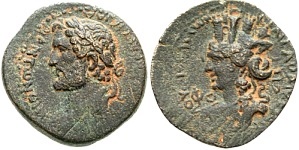

Laodicea ad Mare prospered thanks to the excellent wine produced in the nearby hills and was also famous for its textiles, both of which were exported to all the empire. A sizable Jewish population lived in Laodicea during the first century. Under Septimius Severus the city was fortified and was made for a few years the capital of Roman Syria: in this period Laodicea grew to be a city of nearly 40,000 inhabitants and even had a hippodrome. Christianity was the main religion in the city after Constantine I and many bishops of Laodicea participated in ecumenical councils, mainly during Byzantine times. The heretic Apollinarius was bishop of Laodicea in the 4th century, when the city was fully Christian but with a few remaining Jews. An earthquake damaged the city in 494 A.D. Justinian I made Laodicea the capital of the Byzantine province of "Theodorias" in the early sixth century. Laodicea remained its capital for more than a century until the Arab conquest.RY13481. Bronze AE 25, BMC Galatia, p. 255, 66; SGICV 1497 var., gVF, weight 10.05 g, maximum diameter 25.3 mm, die axis 0o, Laodicea ad Mare (Latakia, Syria) mint, obverse [AVTO] KAI AI ADRI ANTWNEINOC [CEB], laureate bust left; reverse IOYΛIEWN TWN KAI ΛAOΔIKEWN, turreted bust of Tyche left, ΦO left, date ΗΠP right ( year 188 ); fine style, attractive coin and rare in this grade; SOLD
Macrinus, 11 April 217 - 8 June 218 A.D., Laodicea ad Mare, Seleucia Pieria
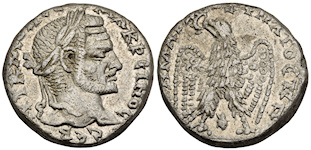

Macrinus was praetorian prefect for Caracalla but arranged Caracalla's assassination and seized power. He and his son were accepted by the Senate. The Syrian legions, inspired by Julia Maesa, Caracalla's aunt, revolted after he concluded an unfavorable peace with the Persians. He was defeated and executed.RY85322. Silver tetradrachm, Prieur 1180, Bellinger Syrian 73, SNG Cop 368, BMC Galatia -, aEF, well centered on a tight flan, porosity, weight 15.126 g, maximum diameter 25.2 mm, die axis 0o, Laodicea ad Mare (Latakia, Syria) mint, late Jul - Sep 217 AD; obverse AYT K M OΠ CE MAKPINOC CEB, laureate, draped, and cuirassed bust right, seen from behind; reverse ΔHMAPX EΞ YΠATOC Π Π (holder of Tribunitian power, consul, father of the country), eagle standing front, wings spread, head left, star between legs; SOLD
Septimius Severus, 9 April 193 - 4 February 211 A.D., Laodiceia ad Mare


Obverse countermarked with monogram of CAΓ?, in rectangular punch, 5 x 3 mm, Howgego 581 (116 pcs) and COL in rectangular punch, 6.5 x 3 mm, Howgego 586 (88 pcs). COL was applied after the city achieved status as colony in A.D. 197/198, allowing older coins to circulate alongside newer coins with Latin legends, although the countermark was also applied to coins with inscriptions in Latin.RP23220. Bronze AE 31, SNG Cop Suppl. 8/249, BMC Galatia -, cf. Lindgren III 1204 (Caracalla), aVF, weight 20.463 g, maximum diameter 30.5 mm, die axis 0o, Laodicea ad Mare (Latakia, Syria) mint, obverse IMP CAES L [...], radiate, draped, and cuirassed bust of Septimius Severus right, and draped bust of Julia Domna behind; reverse […SEVER METROPOLI-SEPT…] or similar, Marsyas walking left, with wine-skin over shoulder; rare; SOLD
Antoninus Pius, August 138 - 7 March 161 A.D., Laodikea ad Mare, Seleucis and Pieria, Syria


RP36266. Bronze AE 25, BMC Galatia p. 254, 57; SGICV 1497 var.; SNG Cop -, gVF, fine style, attractive coin and rare in this grade, weight 11.951 g, maximum diameter 24.5 mm, die axis 0o, Laodicea ad Mare (Latakia, Syria) mint, 140 - 141 A.D.; obverse [AVTO KAI AI ADRI A]NTWNEINOC CEB, laureate bust right; reverse IOYΛIEWN TWN KAI ΛAOΔIKEWN, turreted bust of Tyche left, ΘΕ right, date ΗΠP left ( year 188 ); SOLD
Laodicea ad Mare, Seleucis and Pieria, Syria, 42 - 41 B.C.
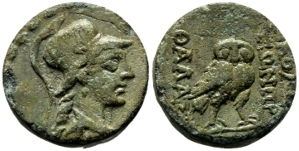

Mark Antony gave Publis Cornelius Dolabella command of the expedition against the province of Syria and the Parthians. After his journey to the province was marked by plundering, extortion, and the murder of Gaius Trebonius, proconsul of Asia, who refused to allow him to enter Smyrna, Dolabella was declared a public enemy. Cassius (the murderer of Caesar) attacked Dolabella in Laodicea in 43 B.C. Cassius battered Laodicea's walls but they held. He tried unsuccessfully to corrupt Marsus, the captain of the night-watch. When Marsus was taking his rest, he bribed the centurions of the day force who secretly opened a number of small gates. When the city was taken, Dolabella told his own bodyguard to cut off his head and carry it to Cassius in order to secure his own safety. The guard cut it off, but then he killed himself. Marsus also took his own life. Cassius swore Dolabella's army into his own service. He plundered the temples and the treasury of Laodicea, punished the chief citizens, and exacted very heavy contributions from the rest so that the city was reduced to the most extreme misery.GB84950. Bronze AE 11, RPC I 4419, Cohen DCA 577 (R1), HGC 9 1416 (R3), SNG Cop -, BMC Galatia -, gVF, nice green patina with tiny edge flakes, light marks, slight porosity, weight 1.884 g, maximum diameter 10.9 mm, die axis 0o, Laodicea ad Mare (Latakia, Syria) mint, 42 - 41 B.C.; obverse head of Athena right in crested helmet; reverse ΛAOΔIKEΩN / TΩN ΠPOΣ / ΘAΛAΣΣHI (of the people of Laodicia on the Sea), owl standing right, head facing, wings closed, Z (year 7 of the Caesarian era) below; extremely rare; SOLD
Septimius Severus, 9 April 193 - 4 February 211 A.D., Laodicea ad Mare, Syria, Julia Domna Reverse
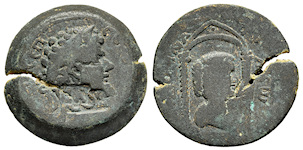

During the reign of Commodus, in 179 A.D., Lucius Septimius Severus was put in command of Legio IV Scythica stationed at Antioch. In Syria, he was introduced to a little girl, Julia Domna, aged nine, the daughter of the high priest of Emesa, Julius Bassianus. Whoever marries this child, the astrologers had predicted, she will make into a king. Severus was devoted to astrology, and both the girl and the fable fascinated him. They married in 187 A.D., when she was 17.RP111028. Bronze diassarion, Meyer 33 (V5/R11); BMC Galatia, p. 258, 81 (same c/ms); SNG Hunterian 3211; Meyer 23 – 34; c/m: Howgego 586 (COL) and 581 (CAΓ), F, deep open flan crack, obv. edge beveled, weight 12.005 g, maximum diameter 26.5 mm, die axis 0o, Laodicea ad Mare (Latakia, Syria) mint, 194 - 197 A.D.; obverse AVT KAI CEΠ CEOYHPOC, laureate, draped, and cuirassed bust of Septimius Severus right, countermarks: COL in a rectangular punch, and CAΓ (AΓ ligate) in a rectangular punch; reverse AYΓ ΔOMNA TYXH MHTPOΠOΛEWC, draped bust of Julia Domna right within distyle shrine; rare; SOLD
Macrinus, 11 April 217 - 8 June 218 A.D., Laodicea ad Mar, Seleucia and Pieria, Syria
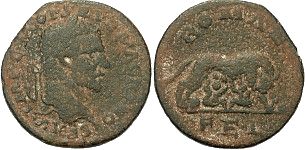

Laodicea ad Mar (Latakia, Syria) has been inhabited since the second millennium B.C. It was on the Via Maris, a coastal road that ran south from Antioch to Damascus and Beirut. The city was renamed by Seleucus I Nicator in honor of his mother, Laodice and was a major port for the Seleukid Kingdom. Laodicea flourished under Rome and was second only to Antioch in the region. Herod the Great, king of Judaea, furnished Laodicea with an aqueduct, the remains of which stand to the east of the town. The Legio VI Ferrata was probably based in Laodicea.RY73049. Bronze AE 30, BMC Galatia p. 261, 97; SNG Munchen 937; SNG Righetti 2121, SGICV 2954; Lindgren-Kovacs 2097; SNG Cop -, aVF, centered, near black patina with red earthen highlighting, weight 9.893 g, maximum diameter 29.5 mm, die axis 0o, Laodicea ad Mare (Latakia, Syria) mint, 217 - 218 A.D.; obverse IMP C M OP SEVE MACRINOS P AV, laureate head right; reverse ROMAE FEL, she-wolf right suckling Romulus and Remus; scarce; SOLD
Antoninus Pius, August 138 - 7 March 161 A.D., Laodikea ad Mare, Seleucis and Pieria, Syria
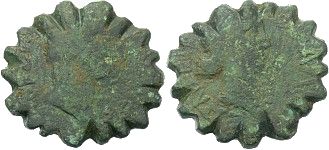

The edge cuts, creating a serrated edge, indicate this coin was modified for use as a weight.RP71905. Bronze AE 25, BMC Galatia p. 254, 57; see Hendin Weights p. 231, 357 for a Roman coin used as a weight and serrated to adjust the weight, F, porous, edge cuts to create a serrated edge - probably used as a weight, weight 7.266 g, maximum diameter 23.3 mm, die axis 180o, Laodicea ad Mare (Latakia, Syria) mint, 140 - 141 A.D.; obverse AVTO KAI AI ADRI ANTWNEINOC CEB, laureate bust right; reverse IOYΛIEWN TWN KAI ΛAOΔIKEWN, turreted bust of Tyche left, ΘΕ right, date ΗΠP left ( year 188 ); SOLD

You are viewing a SOLD items page.
Click here to return to the page with AVAILABLE items.
The sale price for a sold item is the private information of the buyer and will not be provided.



REFERENCES
Page created in 1.204 seconds.






